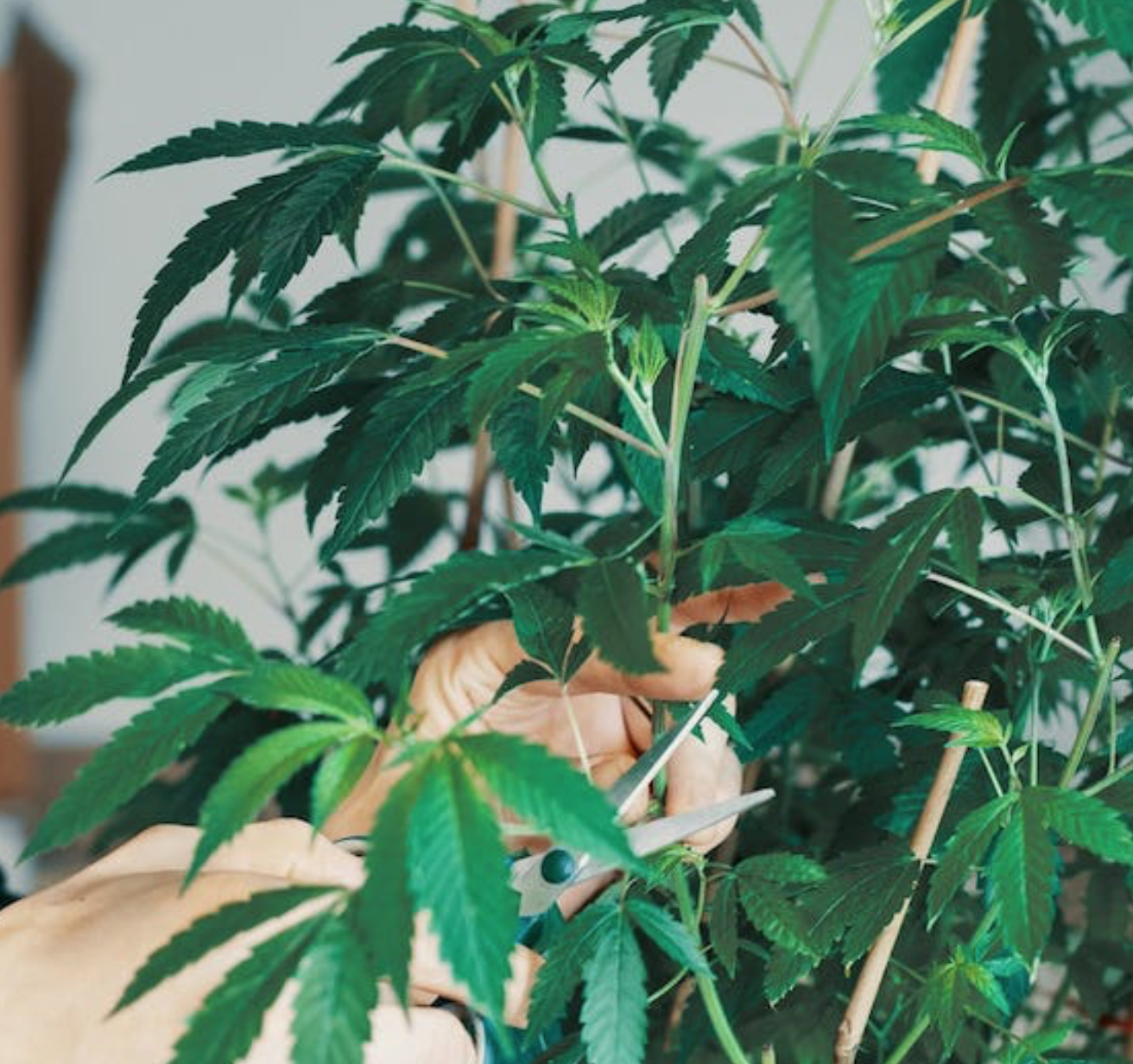Optimizing Cannabis Canopy: The Vital Role of Pruning and Training for Successful Cultivation
Pruning and training techniques play a pivotal role in achieving a thriving and evenly distributed cannabis canopy. Beginning these practices during the vegetative stage sets the foundation for a successful cultivation journey.
Pruning
Pruning is a meticulous process that involves the strategic removal of shaded or less vital leaves and branches. This selective approach fosters uniform growth and enhances airflow throughout the canopy. By eliminating specific portions, we create an environment less conducive to humidity-related issues and potential pest infestations. Targeting lower leaves showing signs of distress is key, ensuring that energy is channeled to more productive parts of the plant.
A crucial step before and after pruning is disinfection. Using rubbing alcohol or sterilizing solutions on pruning tools prevents the spread of diseases, safeguarding plant health.
Further enhancing canopy development is the Low-Stress Training (LST) method, which involves gently bending branches. LST promotes optimal light exposure and encourages bud development. Techniques like topping and FIMing are also employed to trigger the growth of multiple colas, ultimately boosting yields. The Screen of Green (SCROG) technique, using a screen to optimize light distribution, further contributes to enhanced bud production.
Regular monitoring and adjustment are vital aspects of successful pruning. Lower leaf pruning should be performed with care to improve airflow and energy distribution while preserving the main stem. Over time, this practice results in a balanced canopy structure, improved light utilization, and higher yields.
Consistency is key. Regularly pruning and training your cannabis plants not only refine their growth patterns but also lead to healthier plants and a more bountiful harvest. By integrating these techniques, you create an environment where light is efficiently harnessed, ultimately fostering vigorous plant growth and maximizing yield potential.
Training
Regular and gentle training techniques result in a balanced and healthy canopy. Continuously observe plant growth and adjust training techniques as needed to maintain an even canopy. Implement techniques gradually to avoid stressing the plant excessively. Proper training prevents overcrowding and ensures that all buds receive adequate light.
Employ techniques like topping, FIMing, LST (Low-Stress Training), and SCROG (Screen of Green) to shape and maximize canopy growth. Employing techniques like topping, FIMing, LST (Low-Stress Training), and SCROG (Screen of Green) can greatly influence the shape and growth of your cannabis canopy, leading to improved light penetration, even bud development, and ultimately higher yields.
Topping:
Topping involves removing the main apical (top) stem to encourage lateral growth and the development of multiple main colas. Topping creates a more even canopy with multiple flowering sites, increasing overall light exposure. Removing the top growth (main apical bud) encourages multiple colas to develop, leading to increased bud production.
Topping involves removing the main apical (top) growth shoot to encourage the growth of multiple side branches. Cut the main stem just above the fifth or sixth node during the vegetative stage, promoting bushier growth.
FIMing:
Similar to topping, FIMing encourages lateral branching and more colas. Pinch or cut the newest growth tips, leaving about 20-25% of the tip intact to create multiple growing points. FIMing involves pinching or cutting the top growth to stimulate the growth of multiple new branches.
Low-stress Training:
Low-Stress Training (LST) is a gentle bending and securing technique that fosters even growth and maximizes light exposure in cannabis plants. This approach results in a balanced and productive canopy.
LST is a valuable method that promotes healthy and productive cannabis growth while maintaining an effective canopy structure. By employing LST, you optimize light absorption and enhance overall development.
Uniform light distribution and prevention of excessive stretching are benefits of LST. By gently bending and securing branches, you encourage horizontal growth, leading to better light penetration and consistent bud development.
LST encourages lateral growth and aids in creating a discreet and well-balanced canopy. Its versatility allows customization while optimizing yields and plant health. By gently manipulating growth, you achieve controlled growth and ample yields.
Gently bending and securing branches initiates lateral growth and an even, horizontal canopy. Utilize your thumb and forefinger to softly squeeze and soften stems before bending. Implement LST during the vegetative stage when plants are more responsive.
Commence LST once plants have multiple sets of leaves and are sturdy enough for manipulation. Gently bend branches downward and away from the plant's center. Secure branches using soft ties or gardening wire. Avoid excessive bending or aggressive handling. Secure plants with stakes or ties as they grow.
LST enhances light distribution, airflow, and bud development. Gradual implementation over days or weeks, rather than abruptly, prevents plant stress. The technique reduces plant visibility and height through controlled bending, promoting even growth.
Monitor plant response and avoid damaging branches. Ensure all parts receive sufficient light. Implement LST across multiple plants for a uniform canopy.
Low-Stress Training, a nuanced approach, contributes to discreet, well-distributed, and healthier cannabis growth, leading to increased yields.
Staking:
Staking or tying plants provides support for heavy branches and prevents them from bending or breaking due to the weight of flowers. Use bamboo stakes, trellis netting, or other sturdy materials to create a framework for plants to grow against. Begin staking or tying plants as they start to grow taller and develop heavier branches, usually during the vegetative stage. Gently secure branches to stakes using soft plant ties or garden twine. Avoid tying too tightly to prevent damaging the plant. Continuously monitor your plants' growth and adjust ties or stakes as needed to accommodate their development.
Adjust your staking or tying techniques as plants transition through different growth stages and develop heavier buds. Space out ties along branches to ensure they are secured at regular intervals. Use soft plant ties to bend branches away from the center of the plant and secure them to the growing medium.
Regularly check the tied branches to ensure they are not becoming too constricted. As the plant continues to grow, you can adjust the ties to maintain the desired shape and light exposure.
Sea-of-green:
Sea-of-green (SCROG) allows you to control plant height and positioning, maximizing light exposure. Place a screen or net over the canopy and weave branches through it as they grow, creating an even canopy.
SCROG involves using a screen or net to evenly distribute and support branches, maximizing light exposure and bud production. Position the screen about 1-2 feet above the growing medium and weave branches through the openings as they grow. SCROG creates an even canopy, increases light penetration, and enhances yields.
With dedicated practice, you'll refine skills in manipulating plant growth for optimal yields.
Integrate pruning and training with reflective materials for better light distribution. These methods require time and patience but lead to healthier plants and higher yields.
Consistently prune and train plants for uniform canopy growth, improved light penetration, and increased yields.
Ongoing pruning and training enhance your understanding of growth patterns. Over time, master techniques for optimal canopy development and higher yields.
Timing matters for topping, FIMing, LST, and SCROG, which excel during the vegetative stage. Minimal plant stress encourages adaptive growth, optimizing light use and bud production.
Assess growth, adjust training for desired canopy. Experiment with tailored techniques. Master these approaches for improved skills over time.
Use topping, FIMing, LST, and SCROG for growth, light, and bud development. The outcome: a thriving canopy and abundant harvests.

Minnesota Cannabis Clones

